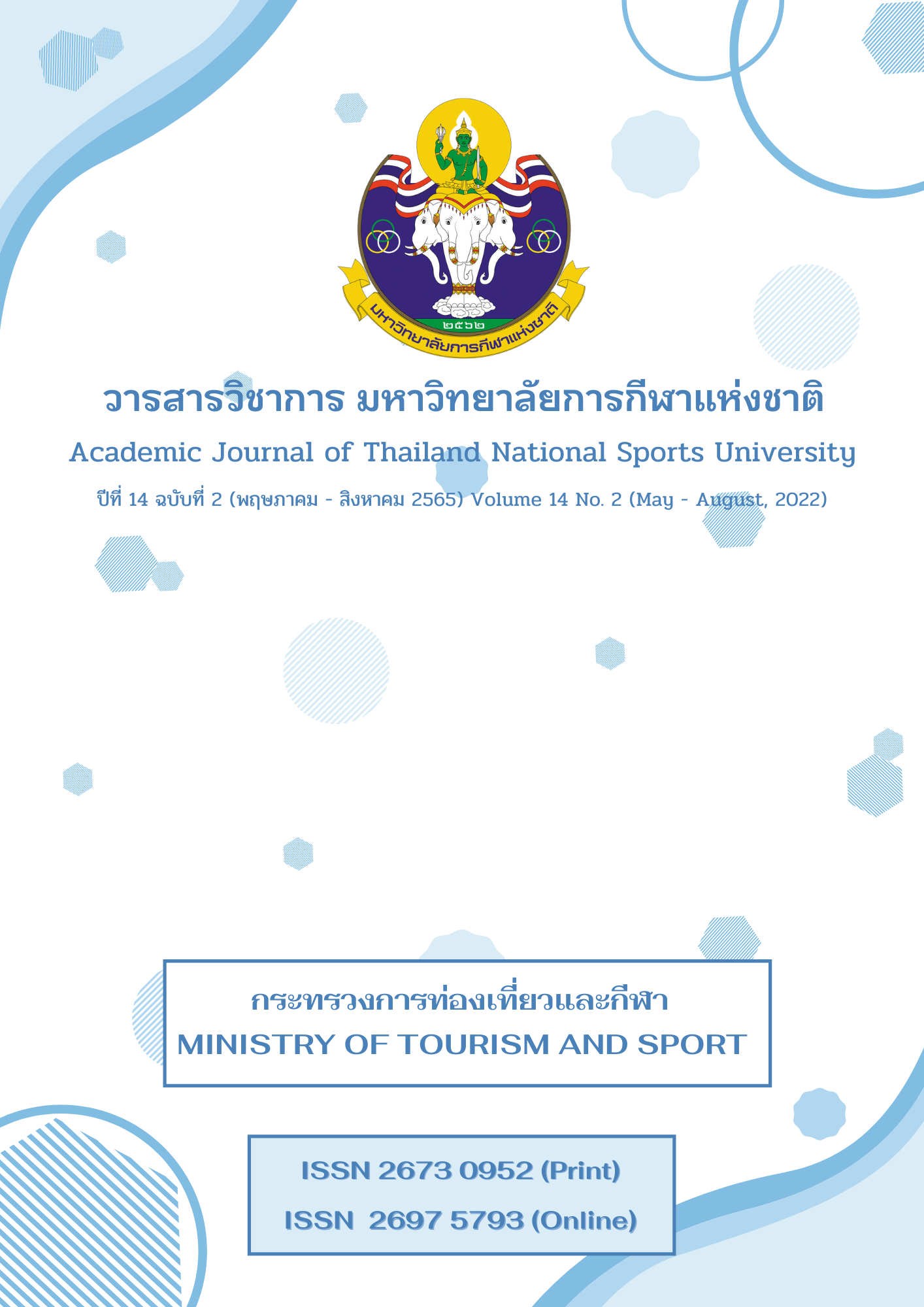EFFECTS OF LEISURE PROGRAM ON WELL-BEING OF JUNIOR HIGH SCHOOL STUDENTS
Main Article Content
Abstract
The objective of this quasi - experimental research was to study the effects of leisure program on the well - being of junior high school students. Samples were 60 students of Anuban Muang Chumphon Watsubannimit School who were selected by wellbeing evaluation, and then match-paired sampling into experimental and control groups (30 for each). The research instruments were: - 1) the well - being evaluation questionnaire - the content validity was approved by 5 leisure experts (IOC = 0.8 - 1.0) as well as the Cronbach alpha coefficient correlation reliability was 0.88, and 2) the leisure program - the face validity was in the most appropriate level. Data were analyzed by using mean, standard deviation, and t - test.
The findings were found that: - 1) after the experimental group attending the 8 - week leisure program, there were more wellbeing than before attending at the statistic of .05; and 2) after attending the 8 - week leisure program, the experimental group had more well-being than the control group at .05. It can be concluded that the leisure program affected the wellbeing of junior high school students. It possesses appropriateness to application.
Article Details

This work is licensed under a Creative Commons Attribution-NonCommercial-NoDerivatives 4.0 International License.
The published article is a copyright of the Academic Journal of Thailand National Sports University. The passage appeared in each article in this academic journal is a perspective of each author which is not related to the journal. Each author is required to be responsible for all components of his/her own article. If there are any mistakes, each author must be responsible for those mistakes on his/her own.
References
Best, J. W. (1970). Research in Education (3rd ed.). NJ: Prentice - Hall.
Carruthers, C., & Hood, C. (2007). Building a life of meaning through therapeutic recreation: The leisure and well - being model, Part 1. Therapeutic Journal, 41(4), 276 - 297.
Committee of Child Development and National Youth. (2018). The 2nd Child and Youth Development National Master Plan. 2017 – 2021 (2). Bangkok: JS Printing.
Department of Physical Education. (2017). The 3rd National Recreation Master Plan 2017-2021. Retrieved from https://www.dpe.go.th/news-files-411891791865
Department of Provincial Administration. (2019). Demographic statistic and housing. Retrieved from http://statbbi.nso.go.th/staticreport/page/sector/th/01.aspx
Hertting, K., & Kostenius, C. (2012). Organized leisure activities and well - being: Children getting it just right. LARNet Spring, 15(2), 13 - 28.
Hood, C., & Carruthers, C. (2007). Enhancing leisure experience and developing resources: The leisure and well - being model, Part 2. Therapeutic Recreation Journal, 41(4), 298 - 325.
Krejcie, R. V., & Morgan, D. W. (1970). Determining sample size for research activities. Educational and Psychological Measurement, 30, 607 – 610.
Matichon. (2017). Sedentary behavior in Thai people 14 hours / day. Matichon Newspaper, 40(14516): 7 December, P. 7
National Strategy Master Plan. (2019). National Strategy Master Plan: Strengthen Thai Citizen Well-being. Retrieved from https://www.shorturl.at/tyZ19
Office of the Basic Education Commission. (2019). Primary Data of Primary Educational Service 1st Area. Retrieved from https://data.boppobec.info/emis/school.php? Area_CODE=8601
Padhy, M., Valli, S. K., Pienyu, R., & Padiri, R. A. (2015). Leisure motivation and well - being among adolescents and young adults. Psychol Stud, 60(3), 314 – 320.
Pinnapa Muakyod. (2015). Development of student potential in promoting intellectual well - being (Doctoral Dissertation), Srinakharinwirot University.
Rossman, J. R., & Schlatter, B. E. (2015). Recreation programming: Designing and staging leisure experiences (6th ed.). IL: Sagamore.
Samrit Somnam, & Amnart Chanawong. (2019). Health condition development model of the students in the small - sized primary schools. Journal of Education, Mahasarakham University, 13(2).
Sarriera, C. J., Casas, F., Bedin, L., Paradiso, A. C., Daniel, A., & González, M. (2013). Aspects of leisure on adolescent’s well - being in two countries. Springer Science, 7, 245 - 265.
Sasithon Jamnongrak. (2015). Effects of participation in leisure motivation program on positive leisure lifestyle of senior high school students (Master’s thesis), Kasetsart University.
Suvimol Tangsujjapoj. (2010). Recreation and Leisure. Bangkok: Adison Place Product Company.
United Nations. (2015). UN Sustainable development summit 2015. Retrieved from https://www.who.int/mediacentre/events/meetings/2015/un-sustainable-development-summit/en/
Urairat Nayai. (2016). The development of spiritual health activity model for children and youth in the juvenile observation and protection center of Pattani Province (Master’s thesis), Prince of Songkla University.
Usanee Petchruschatachart, Karnsunaphat Balthip, & Siriwan Piriyakoontorn. (2016). Life’s assets and quality of life of Thai junior high school adolescent, Songkhla Province. Songklanagarind Journal of Nursing, 36 (Supplement), 56.
Verma, G. (2017). Leisure and well - being among adolescents: A qualitative study. Indian Journal of Health and Wellbeing, 8(8), 936 - 943.
World Leisure Organization. (n.d.). About us. Retrieved from https://www.worldleisure.org/ about-us/
Zhang, J., & Zheng, Y. (2017). How do academic stress and leisure activities influence college students' emotional well - being? a daily diary investigation. Journal of Adolescence, 60, 114 - 118.


